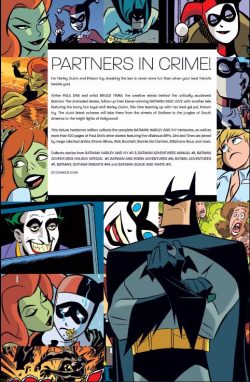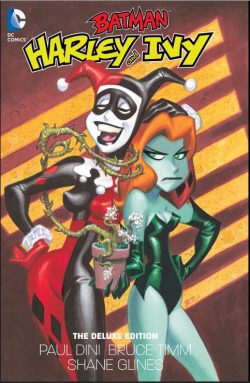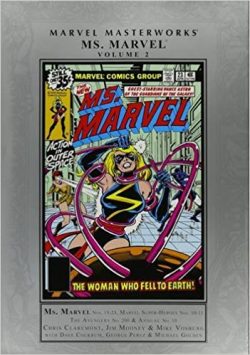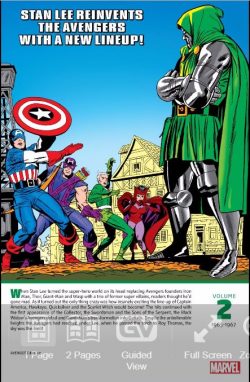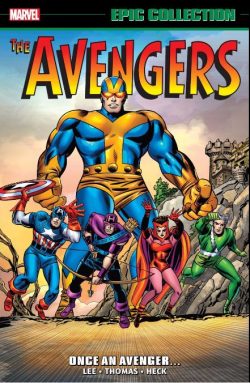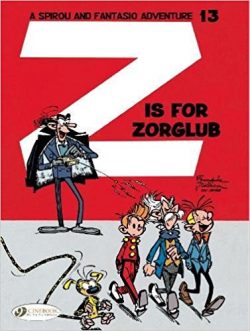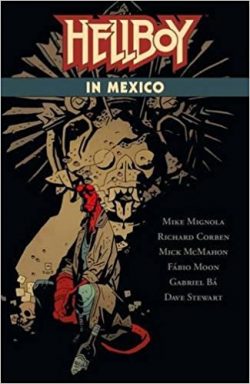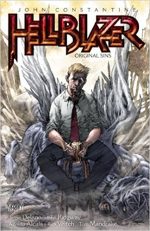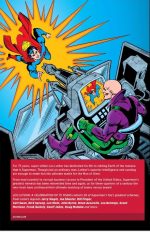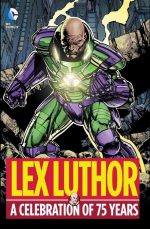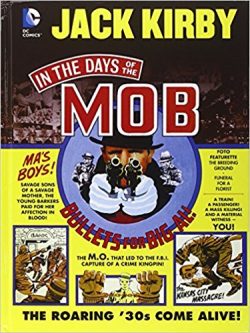
By Jack Kirby, Vince Colletta, Mike Royer Sergio Aragonés & various (DC Comics)
ISBN: 978-1-4012-4079-0
Win’s Christmas Gift Recommendation: An Ideal Alternative to Any Movie Blockbuster… 9/10
There’s a magnificent abundance of Jack Kirby collections around these days (though still not every single thing he ever did, so I remain a partially disgruntled fan) and this sturdy oversized hardback re-presents the complete “King’s Canon†of one his most personal – yet subsequently misunderstood and mishandled – DC projects.
Famed for his larger than life characters and gigantic, cosmic imaginings, “King†Kirby was an astute, spiritual man who had lived through poverty, gangsterism, the Depression and World War II – all grist for his imaginative mill and the basis for this particular publishing project.
He saw Post-War optimism, Cold War paranoia, political cynicism and the birth and death of peace-seeking counter-cultures. He was open-minded and utterly wedded to the making of comics stories on every imaginable subject.
On returning from World War II, with his long-term creative partner Joe Simon, he created the entire genre of Romance comics for the Crestwood/Prize publishing outfit. Prior to that, however, Joe and Jack plundered history books and the daily papers to craft a raft of edgy, adulted oriented crime thrillers for titles such as Headline Comics, Real Clue Crime Stories and Justice Traps the Guilty. The genre was one they made uniquely their own…
Changing tastes and an anti-crime, anti-horror witch-hunt quashed the comics industry, so under a doctrinaire, self-inflicted conduct code, publishers stopped innovating and moved into more anodyne areas. This established holding pattern persisted until the rebirth of superheroes.
Working at a little outfit dubbed “Atlasâ€, Jack partnered with Stan Lee and when superheroes were revived, astounded the world with a salvo of new concepts and characters that revitalised if not actually saved the comics business.
Kirby understood the fundamentals of pleasing his audience and always toiled diligently to combat the appalling state of prejudice about the type-and-picture medium – especially from insiders and professionals who despised the “kiddies’ world†they felt trapped in.
However, after a decade or so, costumed characters again began to wane. Public interest in genre topics and the supernatural was building, with books, television and movies all exploring the subjects in gripping and stylish new ways.
The Comics Code Authority was even ready to slacken its censorious choke-hold on horror titles to save the entire industry from implosion as the 1960s superhero boom fizzled out.
Experiencing increasing editorial stonewalling and creative ennui at Marvel, in 1970 Kirby accepted a long-standing offer from arch rival National Periodical Publications AKA DC Comics…
Before he was let loose on DC’s continuity with his epic, controversial, grandiose Fourth World project Kirby looked for other concepts which would stimulate his vast creativity and still appeal to an increasingly fickle market. General interest in the supernatural was rising, and America was enjoying a protracted love affair with period gangster yarns thanks to shows like The Untouchables, and books and movies such as The Godfather and Bonnie and Clyde…
Promised freedom to innovate, one of the first projects he tackled was a new magazine format carrying material targeting adult readerships. He devised Spirit World – a supernatural-themed, adult-oriented monochrome magazine – and sister title In the Days of the Mob, dedicated to revisiting the heady era when crime ran wild in America.
For the full story of how that worked out, you can read Mark Evanier’s acerbic article in companion volume Jack Kirby’s Spirit World. The net result of constant editorial cowardice and backsliding was that Kirby and his small team were left to create magazines that DC didn’t promote or support and cancelled even before they hit the news-stands.
After decades of obscurity the work was at last gathered into two glorious and oversized (282 x 212 mm) hardback compilations, each collecting the superb but poorly received and largely undistributed first issues launched in the summer of 1971, plus whatever remained of the unpublished second issues.
In the Days of the Mob #1-and-only was released with no discernible marks or connections to DC/National Comics with a September 1971 cover-date through a subsidiary called Hamilton Distribution and vanished without trace. The historical details plus other contextual treasures are provided in ‘Crime and Punishment Pinball: An Introduction by John Morrow’ wherein the esteemed historian, collector and publisher describes the state of play in the Bad Old Days, before the comics wonderment begins.
Ghetto-kid Kirby used his own childhood experiences to flavour the graphic reconstructions of the explosive careers of legendary gangsters and this long-awaited revival In the Days of the Mob forsakes continuity in favour of plot and mood-driven tales related by a sinister narrator-host.
Printed in redolent sepia monotones, the premier issue combined comics stories (because DC wouldn’t spring for colour photography) with prose and monochrome “Foto-Featuresâ€, all furiously fuelled by the King’s unique perspective.
Inked by Vince Colletta the stories were journalistic biographs delivered with a supernatural twist as the stories came direct from the horse’s mouth from the Ultimate Big House as seen in ‘Welcome to Hell!’ which introduced the sardonic Warden Fry, gatekeeper of a hell made especially for mobsters and murderers.
The first of Fry’s cautionary tales is ‘Ma’s Boys’, detailing the rise and fall of the infamous Barker bandit clan and their psychopathic domineering mother, after which ‘Bullets for Big Al’ offers just one little snippet from a modern mythology packed with atrocious acts of violence.
Featurette ‘The Breeding Ground’ then provides a word-&-photo snapshot of the era’s poverty and privations whilst text article ‘Funeral for a Florist’ by Mark Evanier and Steve Sherman describes the war between Capone and Johnny Torrio for control of Prohibition-era Chicago, after which graphic action resumes with the lowdown on the ‘Kansas City Massacre’ of FBI agents which made Pretty Boy Floyd a legend and Public Enemy No. 1.
Obsessive angler Country Boy is caught by examining his ‘Method of Operation’ before Sergio Aragonés lightens the mood with two pages of gangster gags in ‘Killjoy was Here’ and the criminal capers conclude with a reproduction of the ‘John Dillinger Wanted Poster’ that came free with the original magazine.
Comics need a huge amount of creative lead-in and preparation and by the time Kirby learned the title was scrubbed the second issue was all but complete. Here, for the first time fans can now see how the magazine might have developed as – inked by Mike Royer and printed in standard black line – the majority of that unpublished material follows.
Leading off is a salutary moment with Warden Fry and a double-page spread starring Hitler before the bloody vendetta between Brooklyn brothers Meyer, Willie and Irving Shapiro and aspiring mobster Kid Twist led to the creation of organised crime in the form of ‘Murder Inc.’
Devised as a full-length account the story diverts to describe ‘The Ride!’ as Twist orders his pet goons to get rid of a stool-pigeon giving information to up-&-coming lawman Thomas E. Dewey…
Another diversion follows as Kirby details ‘the Colorful, Beautiful, Pragmatic, Inscrutable, Ladies of the Gang!’ revealing how Mrs. Tootsie, Miss Murder Inc., The Kiss of Death Girl and the Decent Kid make the best of life as attendants (willing or otherwise) of men with a price on their heads, before the saga comes to savage end in ‘A Room for Kid Twist!’
Wrapping things up is a rare comedy outing for Kirby as he postulates a variety of technical innovations crooks might benefit from in an outlandish catalogue of ‘Modern Technology and the Getaway Car!’
Jack Kirby always was and remains a unique and uncompromising artistic force of nature: his words and pictures are an unparalleled, hearts-&-minds grabbing delight no comics lover could resist. If you’re not a fan or simply not prepared to see for yourself what all the fuss has been about then no words of mine will change your mind.
That doesn’t alter the fact that Kirby’s work shaped the entire American scene and indeed the entire comics planet – affecting the lives of billions of readers and thousands of creators in all areas of artistic endeavour for generations. He’s still winning new fans and apostles, from the young and naive to the most cerebral of intellectuals. In this, his centenary year, Jack’s work is still instantly accessible, irresistibly visceral, deceptively deep whilst simultaneously mythic and human.
Wherever your tastes take you, his creations will be there ready and waiting. So, if cops and robbers are your bag, it would a crime to miss out on these classic treasures.
© 1971, 2013 DC Comics. All Rights Reserved.

